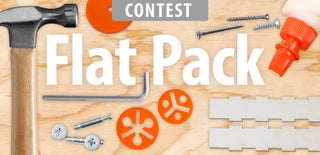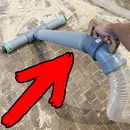Introduction: Window Jamb Garden
What could be better than having a herb garden in a tiny flat? A garden that does not take up any usable space while looking awsome!
Longing for more greenery in our 18 m2 (194 ft2 ) flat motivated me to find ingenious ways to grow herbs. After meditating a while I had a vision of vertical garden made from scraps an recycled materials. The idea was to use up empty space on our window jambs. This was great because they were not serving any practical use anyways.
This project taught me a lot and I would like to share this knowledge with you. If you are here to just get inspiration I suggest you see the video I made. But if you plan to build something similar I recon you read this istructables, because I have included many tips and tricks which will come real handy.
Step 1: Tools and Materials
Materials:
- Wine bottles ( preferably empty, but if you do not have any I suggest you get to work)
- Timber ( I used 3 cm thick Oak )
- Small screws
- Metal construction plate
- Decorative brass screws
Tools list is kinda long for such small project .
- Table saw
- Miter saw
- Hole saw
- Chop saw
- Glass cutter
- Drill press
- Forstner bit
- Chisel
- Sandpaper
- Countersink
- Small drill bits
- Cordless drill
Step 2: The Wine Bottles
Starting off with cutting the glass.
Tip 1: Remove the labels by soaking the bottles in hot water for a while and then scraping off the paper with a knife. This insures a better score line and higher chance of the bottle breaking in the right place.
Tip 2 : Get more bottles than you intend do use because they will scatter. Also try to get bottles that are from same brand. This way they will have same wall thickness and will behave (somewhat) the same. My bottles were each different and close to 50% broke during the process.
I built a simple jig to get persistent score line. I noticed that better results came when I scored the line one time with firm hand.
Tip 3 : Build jigs to get persistent results. Specially if you are working with higher quantities.
After that I continued in kitchen. I boiled water and poured it on the score line. Right after that I let it cool under cold water. I repeated the process until the bottle broke.
Tip 4 : Bottles will eventually break but not always on the score line. This will cause a lot of frustration but do not give up. Just grab another one and try again. Also do not try to remove little pieces left on the edge. This will just break the glass in undesired way. It is easier to sand them off later.
Next up it was back to workshop for sanding. I took ceramic tile and put 150 grit sandpaper on it. This was to remove most of the material and to get the edge straight. Then I repeated the process with 360 grit wet sandpaper to polish it. The edge is not really sharp enough to cut but I recommend you also sand the outside and inside edge. I will tell you why in the end of this instructable.
Step 3: The Bases
I started off by ripping my oak to width of 10 cm (4 inches). Then I cut it into 10 cm long pieces on miter saw.
Tip 5: Use stop block on your miter saw to get all the pieces the same size.
I removed the centering bit on the hole saw so that I would not have a unattractive hole in the bottom. Doing this means that the saw will be super hard to control. I had to build another jig to hold the base piece firmly to drill press (see pictures). Do not even think of doing this freehand! Checking the depth stop three times is also a good idea. When the outside perimeter was drilled out, I removed most of the inside with forstner bit. The rest was easy peasy with sharp chisel. Or you could just invest in 3 inch forstner bit and be done with it.
I cut an 20 degree angle to the sides with miter saw ( stop block!).
Sanding was kinda dull. First with 100 grit to remove the imperfections and then 240 grit to give a finer look. Lots and lots of elbow grease, unless you have a decent belt sander ;)
To finish I soaked the blocks in linseed oil for a few minutes.
Step 4: The Mounts
This was definitely the hardest part on this project.
Because I have double windows I needed a way to fast and easily remove flower pots to open the windows. After a long thought I found a good solution. A while ago I saw instructables user seamster use keyhole hangers on his Simple Heavy-Duty Shelves. This method insured strong hold and easy removabilty, which was just what I was looking for. But since my bases were only 3 cm thick I could not use ones that he mentioned in his project (they were 4,4 cm ). I decided to try to make custom ones for my design but boy was this hard! After three tries I got it to somewhat acceptable condition. The problem was that they had to have same dimensions to work correctly. Doing this freehand meant that they came out as unique as snowflakes.
- I took 2 mm thick metal stock and cut it to size with angle grinder, drilled holes and countersunk on drill press and cut a notch for the screw with angle grinder. This was a total failure. Freehand was not an option.
- I decided to go with 2 mm thick construction plate ( used to connect wooden parts). This method meant that I did not have to drill holes. I attached jig saw with metal cutting blade upside down and added a little fence to guide my cuts. This could have worked but the cuts were not as straight as I hoped and I left it there.
- Finally I decided to use my chop saw to cut the construction plate to size. Eyeballing and a stop block gave me goon enough result.
I traced the dimensions of the hanger on the back side of the block and chiseled out enough material so that the hanger was flush with the edge (or sat just under it). Pilot holes for the screws and small groove ( with drill bit) for the attaching screw and it was ready to assemble.
Step 5: Wrap Up
Because the bottles do not have holes in the bottom the excess water can´t get out. Instead I added a thin layer of pebbles covered with landscape fabric so that soil could not mix with pebbles. This way the excess can drain to the bottom.
To make the pots snug fit I added small 1mm plastic shims to the base. Normally these things are used in construction to level flooring, walls etc.
I am pretty happy with how this turned out. What do you think?
If you like this project be sure to give it a vote in the contest and if you would like to see more stuff that I build consider subscribing to my instructables and youtube page.
Cheers
Step 6: Alternative Use
And of course during winter time when plants don´t really grow these flower pots could be stored away or could be used to serve everyones favorite beverage! (aka. beer)
Just be sure to sand the edge of the glass well if you don´t want to explain people where you got these scars from! (hihihahahaa..... and I thought my jokes were bad)

Participated in the
Urban Farming Contest

Participated in the
Flat Pack Contest













